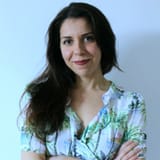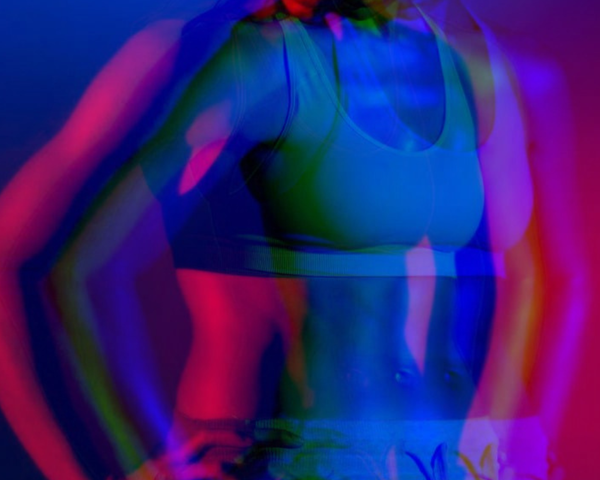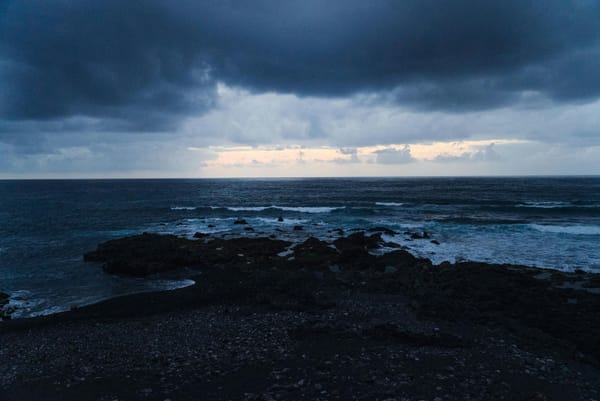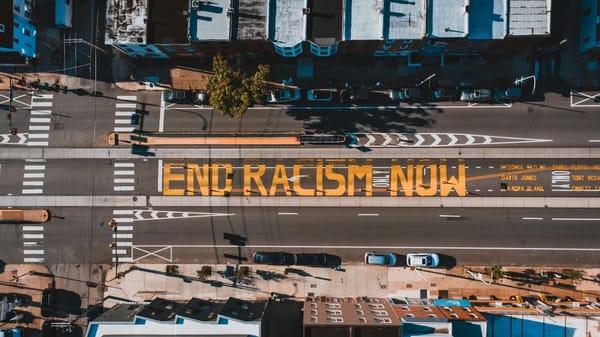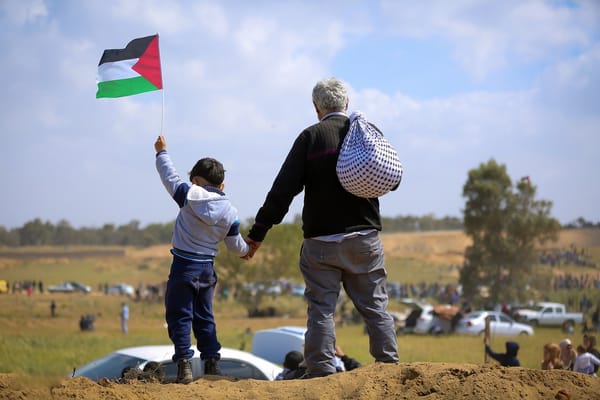"Society will always try to label who I am based on what I look like, so I try to paint that."
Mafalda Vasconcelos on art, identity and the divine feminine
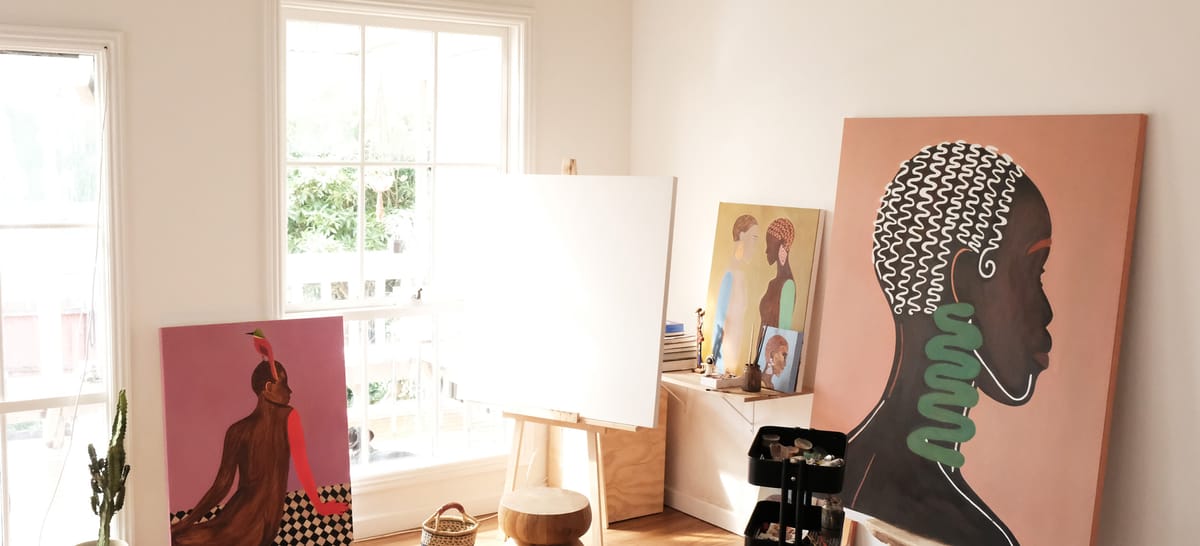
Access the Audio Read version of this article directly on Spotify for Podcasters.
“My family has lost their connection to their culture, which is devastating. Society has tried to erase this culture and story and fill it with the European account.”
If inspiration and the thrill for life have felt scarce in the past year, we are with you. But one of the good things that happened in 2020 was finding new ways to connect to art, most of the time through a screen and from the comfort of our own homes. The art world was deeply impacted by the COVID-19 crisis but artists have continued to inspire us, with some learning new ways to create, and a deeper meaning behind art. A good example is artist Mafalda Vasconcelos, who tells stories of identity and ancestry through colourful paintings, and who inspires us daily.
Identity - and its complexity - is the core of Mafalda Vasconcelos’ work, and one must know the artist’s heritage to get a deeper understanding of her work. Melbourne-based Vasconcelos, who is of Mozambican and Portuguese descent, was born in South Africa but grew up in Mozambique, surrounded by her Mozambican family and culture. Her mother and her family are native Mozambican, and her father comes from a Portuguese family. After studying fashion, Vasconcelos wanted to create things with purpose, and started pursuing art.
As she describes herself, Vasconcelos creates artwork that is sometimes inspired by the likeness and general emotion of the women that surrounded her growing up, but also as a way to connect to her bi-racial identity. Vasconcelos draws or paints female figures as a reference to her mixed identity, the Divine feminine but ultimately tries to explore the connection between life and death.
We connected with Mafalda Vasconcelos to talk about the many layers of her work, and navigating her heritage through art.
What would be the best description of you and your work?
A personal investigation of my mixed identity; how that is manifested physically and emotionally. My work consists of female busts, heads, or faces whose features are abstracted into colourful geometric shapes and lines. Each bust or head represents a spirit or a soul, that transports human emotion. It is a reference to my Nharinga culture and trying to keep that cultural identity alive.
What led you to become the artist you are? What was your journey?
I knew I was going to be an artist from a young age, but I always ignored that and tried to pursue other paths. I studied Fashion and Design and then Entrepreneurship. Art kept creeping into my life, everywhere. And so, I finally decided to go for it. In the beginning, it was hard - I had to create my own opportunities, work multiple jobs to support this labor of love.


How does your art help you reflect on your own identity, whether as a bi-racial woman or any other aspect of human existence?
To me, Art is a celebration of humanity. Through art, I can question my humanity and my identity, and start to explore the answers by educating myself and also by looking within for the answers. It is an intuitive process that allows introspection.
In terms of being bi-racial, that means that society will always try to label who I am based on what I look like. And so, I try to paint that: for mixed-race people, they are seen as something out of their control and often in a way that doesn’t relate to their experience or background. If I paint a woman using blue, orange, green, red, and tan, what is the identity that others see and recognize? Does that relate to how she sees herself?
Are the women in your work always paying homage to the women in your life and your ancestry?
Always. I grew up in Mozambique, surrounded by my Mozambican family. I’ve learnt in the past 2 years that my mother’s family is from a small ethnic group called Nharinga, from the North of Mozambique, in Zambezia. Due to assimilation, most of their culture has been lost and because they were so isolated, there is almost no information about them that I can research. My family has lost their connection to their culture, which is devastating. Society has tried to erase this culture and story and fill it with the European account.
I know everything about the heritage of my Father, who is a European man. Their family tree, where they come from, their history for the last 600 years is known and accounted for.
Through my work, I piece together parts of my Mozambican culture from the Nharinga group and fill in the gaps of my identity. I pay homage to the women in my family, as they are the last direct link to this culture.
You’ve talked about the divine feminine before, how does it manifest in your life?
The female figures around me hold a central place in every aspect of my life. Identifying as a woman, I can more easily relate to it spiritually than to the more “masculine” side. I recognise the divine feminine in the Nharinga culture as it was based in matriarchy; where the central figure in the society is powerful, nurturing, sacred, empowering.
What inspires you daily? Have your inspirations changed over the years?
My daily inspiration is definitely my mother. My mother’s family was extremely poor; my mother walked to school barefoot because she had no shoes to wear. They lived off church donations if there were any in their small village. At 9 years old, she had to leave school to work in a shop, to help support her 4 siblings. She has overcome and achieved incredible things, and I think of that every day. Every day, I am reminded of how fortunate I am to be able to do the work I do, with purpose.
How has your artistry process been in 2020? Was it altered because of Covid at all?
I live in Melbourne; Australia and we were basically in lockdown for 8 months in 2020. It was tough, it felt lonely, especially since all of my family lives in Mozambique and I can’t see them. This time has allowed me to search for deeper meaning in everything, especially in creating. I spent a substantial amount of time experimenting with new techniques and forms of representation, which has been a great learning tool for me.
Is there one particular artwork you are more sentimentally attached to than others, one you are most proud of?
Nolwandle. She is one of a kind and is the main matriarchal figure in my home. It was made as an ode to my culture, where the woman is at the center of everything. A painting I made inspired by Faneta Alfoi, our beloved great-grandmother.


Did you have a lightbulb moment, or breakthrough when you thought this was going to be your career?
It happened organically. I had always known but avoided art because I thought there was no future in it for me. But I was wrong.
Are there specific elements or structures you always make sure to always incorporate in your work?
Colour always, as a reference to my mixed identity and also as a way of exploring emotion. Female forms, as a reference to the women in my life.
The repetition of the m (wiggly/ wave form = mmmm) – stands for Mother (mae in portuguese), Mulher (woman in portuguese), Mafalda (my name), Maria (the middle name of most of my ancestors), Moçambique (where I am from); mestiça/ mulata (mixed-race). In symbolic and simplistic terms, that shape is my whole identity.
How much do you research for your work? And where?
Research is crucial to my practice, not in visual terms but in a spiritual way – sounds strange, I know. I read a lot of academic research studies on the beliefs and spiritual practices of the ethnic groups that would have surrounded our own (Makonde, Makuas…), there would probably be a few similarities in culture with my ancestors. I find that inspiring and motivating. I don’t look at it for visual inspiration but rather as motivation, I try to keep my work my own expression of emotion and identity. I also research the use of ritualistic masks in Mozambique; I find that both art and spirituality are always linked in traditional cultures, and that is inspiring to my practice.
Are you planning any exhibitions in the future (guidelines allowing)?
Not at the moment. My focus right now is to create freely and spontaneously and see where that leads.
Are you happy with the way your work has been received? What do you wish more people knew about your works, or took from them?
What I do feels so personal, it is about my own story and people around me. For the most part, my work has been well received. I think it is interesting that people interpret or identify with my work to their likeness, sometimes regardless of what is actually depicted. I would say most of my work has been depicting colourful women who are mixed race, as a reference to my mixed identity. Some of it has been depicting black women as a tribute to the women in my life. But my work is evolving as I am discovering more about how I relate to my identity.
Right now, I am thinking more about duality, not so much in my physical identity (being black and white) but in the duality of Being. The opposing forces within all of us – the awareness and the ego.
Do you have any advice for the next generation of artists walking in your footsteps?
Honour your story and the humanity in others.
For more information about Mafalda Vasconcelos and discover her work, check out her website or connect with Mafalda Vasconcelos on Instagram.

